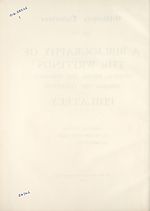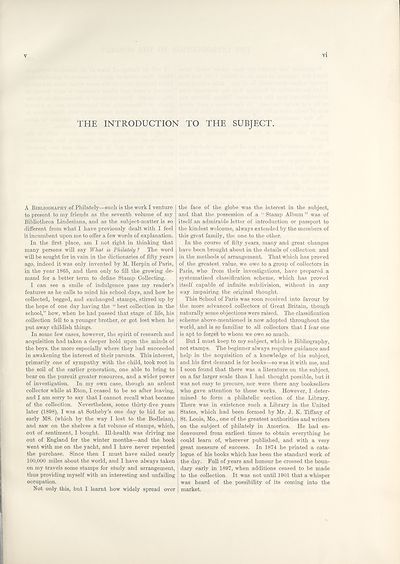Bibliography of the writings, general, special and periodical forming the literature of philately
(11) Columns v and vi
‹‹‹ prev (10)
Verso of title page
(12) next ›››
Columns vii and viii
Download files
Complete book:
Individual page:
Thumbnail gallery: Grid view | List view

VI
THE INTRODUCTION TO THE SUBJECT,
A Bibliography of Philately—such is the work I venture
to present to my friends as the seventh volume of my
Bibliotheca Lindesiana, and as the subject-matter is eo
different from what I have previously dealt with I feel
it incumbent upon me to offer a few words of explanation.
In the first place, am I not right in thinking that
many persons will say What is Philately ? The word
will be sought for in vain in the dictionaries of fifty years
ago, indeed it was only invented by M. Herpin of Paris,
in the year 1865, and then only to fill the growing de¬
mand for a better term to define Stamp Collecting.
I can see a smile of indulgence pass my reader's
features as he calls to mind his school days, and how he
collected, begged, and exchanged stamps, stirred up by
the hope of one day having the " best collection in the
school," how, when he had passed that stage of life, his
collection fell to a younger brother, or got lost when he
put away childish things.
In some few cases, however, the spirit of research and
acquisition had taken a deeper hold upon the minds of
the boys, the more especially where they had succeeded
in awakening the interest of their parents. This interest,
primarily one of sympathy with the child, took root in
the soil of the earlier generation, one able to bring to
bear on the pursuit greater resources, and a wider power
of investigation. In my own case, though an ardent
collector while at Eton, I ceased to be so after leaving,
and I am sorry to say that I cannot recall what became
of the collection. Nevertheless, some thirty-five years
later (1898), I was at Sotheby's one day to bid for an
early MS. (which by the way I lost to the Bodleian),
and saw on the shelves a fat volume of stamps, which,
out of sentiment, I bought. Ill-health was driving me
out of England for the winter months—and the book
went with me on the yacht, and I have never repented
the purchase. Since then I must have sailed nearly
100,000 miles about the world, and I have always taken
on my travels some stamps for study and arrangement,
thus providing myself with an interesting and unfailing
occupation.
Not only this, but I learnt how widely spread over
the face of the globe was the interest in the subject,
and that the possession of a "Stamp Album" was of
itself an admirable letter of introduction or passport to
the kindest welcome, always extended by the members of
this great family, the one to the other.
In the course of fifty years, many and great changes
have been brought about in the details of collection and
in the methods of arrangement. That which has proved
of the greatest value, we owe to a group of collectors in
Paris, who from their investigations, have prepared a
systematised classification scheme, which has proved
itself capable of infinite subdivision, without in any
way impairing the original thought.
This School of Paris was soon received into favour by
the more advanced collectors of Great Britain, though
naturally some objections were raised. The classification
scheme above-mentioned is now adopted throughout the
world, and is so familiar to all collectors that I fear one
is apt to forget to whom we owe so much.
But I must keep to my subject, which is Bibliography,
not stamps. The beginner always requires guidance and
help in the acquisition of a knowledge of his subject,
and his first demand is for books—so was it with me, and
I soon found that there was a literature on the subject,
on a far larger scale than I had thought possible, but it
was not easy to procure, nor were there any booksellers
who gave attention to these works. However, I deter¬
mined to form a philatelic section of the Library.
There was in existence such a Library in the United
States, which had been formed by Mr. J. K. Tiffany of
St. Louis, Mo., one of the greatest authorities and writers
on the subject of philately in America. He had en¬
deavoured from earliest times to obtain everything he
could learn of, wherever published, and with a very
great measure of success. In 1874 he printed a cata¬
logue of his books which has been the standard work of
the day. Full of years and honour he crossed the boun¬
dary early in 1897, when additions ceased to be made
to the collection. It was not until 1901 that a whisper
was heard of the possibility of its coming into the
market.
THE INTRODUCTION TO THE SUBJECT,
A Bibliography of Philately—such is the work I venture
to present to my friends as the seventh volume of my
Bibliotheca Lindesiana, and as the subject-matter is eo
different from what I have previously dealt with I feel
it incumbent upon me to offer a few words of explanation.
In the first place, am I not right in thinking that
many persons will say What is Philately ? The word
will be sought for in vain in the dictionaries of fifty years
ago, indeed it was only invented by M. Herpin of Paris,
in the year 1865, and then only to fill the growing de¬
mand for a better term to define Stamp Collecting.
I can see a smile of indulgence pass my reader's
features as he calls to mind his school days, and how he
collected, begged, and exchanged stamps, stirred up by
the hope of one day having the " best collection in the
school," how, when he had passed that stage of life, his
collection fell to a younger brother, or got lost when he
put away childish things.
In some few cases, however, the spirit of research and
acquisition had taken a deeper hold upon the minds of
the boys, the more especially where they had succeeded
in awakening the interest of their parents. This interest,
primarily one of sympathy with the child, took root in
the soil of the earlier generation, one able to bring to
bear on the pursuit greater resources, and a wider power
of investigation. In my own case, though an ardent
collector while at Eton, I ceased to be so after leaving,
and I am sorry to say that I cannot recall what became
of the collection. Nevertheless, some thirty-five years
later (1898), I was at Sotheby's one day to bid for an
early MS. (which by the way I lost to the Bodleian),
and saw on the shelves a fat volume of stamps, which,
out of sentiment, I bought. Ill-health was driving me
out of England for the winter months—and the book
went with me on the yacht, and I have never repented
the purchase. Since then I must have sailed nearly
100,000 miles about the world, and I have always taken
on my travels some stamps for study and arrangement,
thus providing myself with an interesting and unfailing
occupation.
Not only this, but I learnt how widely spread over
the face of the globe was the interest in the subject,
and that the possession of a "Stamp Album" was of
itself an admirable letter of introduction or passport to
the kindest welcome, always extended by the members of
this great family, the one to the other.
In the course of fifty years, many and great changes
have been brought about in the details of collection and
in the methods of arrangement. That which has proved
of the greatest value, we owe to a group of collectors in
Paris, who from their investigations, have prepared a
systematised classification scheme, which has proved
itself capable of infinite subdivision, without in any
way impairing the original thought.
This School of Paris was soon received into favour by
the more advanced collectors of Great Britain, though
naturally some objections were raised. The classification
scheme above-mentioned is now adopted throughout the
world, and is so familiar to all collectors that I fear one
is apt to forget to whom we owe so much.
But I must keep to my subject, which is Bibliography,
not stamps. The beginner always requires guidance and
help in the acquisition of a knowledge of his subject,
and his first demand is for books—so was it with me, and
I soon found that there was a literature on the subject,
on a far larger scale than I had thought possible, but it
was not easy to procure, nor were there any booksellers
who gave attention to these works. However, I deter¬
mined to form a philatelic section of the Library.
There was in existence such a Library in the United
States, which had been formed by Mr. J. K. Tiffany of
St. Louis, Mo., one of the greatest authorities and writers
on the subject of philately in America. He had en¬
deavoured from earliest times to obtain everything he
could learn of, wherever published, and with a very
great measure of success. In 1874 he printed a cata¬
logue of his books which has been the standard work of
the day. Full of years and honour he crossed the boun¬
dary early in 1897, when additions ceased to be made
to the collection. It was not until 1901 that a whisper
was heard of the possibility of its coming into the
market.
Set display mode to: Large image | Transcription
Images and transcriptions on this page, including medium image downloads, may be used under the Creative Commons Attribution 4.0 International Licence unless otherwise stated. ![]()
| Bibliotheca Lindesiana catalogues > Bibliography of the writings, general, special and periodical forming the literature of philately > (11) Columns v and vi |
|---|
| Permanent URL | https://digital.nls.uk/105642973 |
|---|
| Description | Privately printed catalogues of the special collections of the Bibliotheca Lindesiana, the family library of the Earls of Crawford and Balcarres. Reformation Tracts, English Newspapers and De Bry Collection catalogues provide the only record of the contents of these collections. Also include catalogues of Bibliotheca Lindesiana collections now held elsewhere. |
|---|